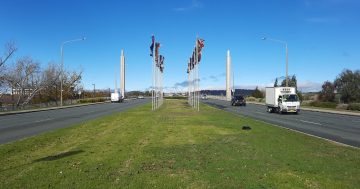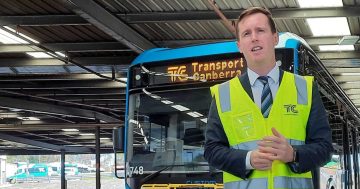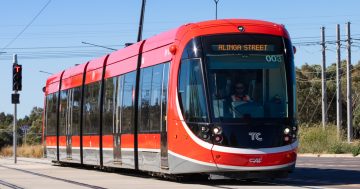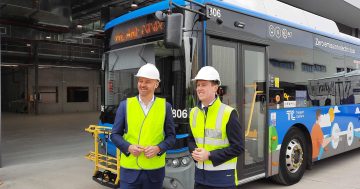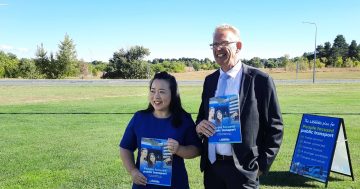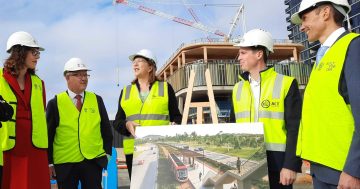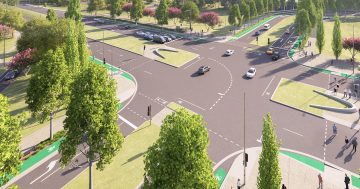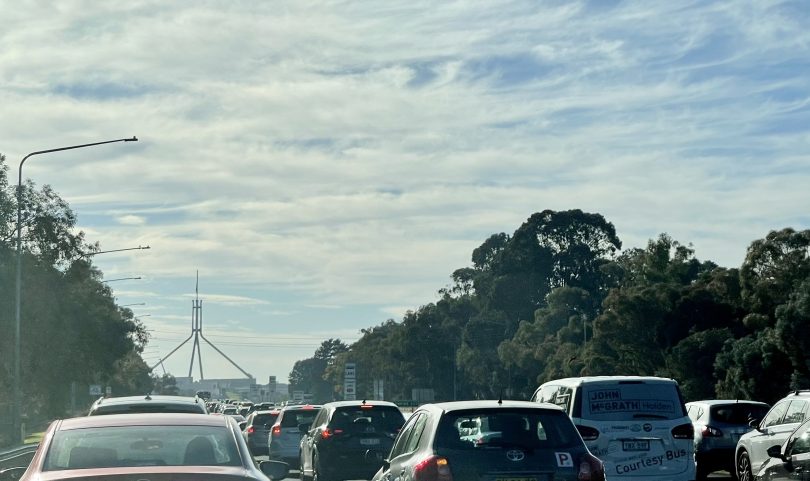
Traffic banked up along Adelaide Avenue. The government says staggered hours may help ease the squeeze. Photo: Supplied.
The Canberra Liberals may have ridiculed the idea, but the ACT Government’s staggered-hours proposal to ease peak traffic congestion as part of its Public Transport Recovery Plan is nothing new.
Singapore has had such schemes for years, Honululu trialled a scheme as far back as the late 1980s and most developed economies, where flexible hours are already part of the modern work landscape, are using or considering versions as part of their recovery from the economic disruption of the pandemic.
Transport Canberra and City Services Minister Chris Steel says traffic volumes in Canberra are currently exceeding pre-pandemic levels because people have not yet returned to public transport, a trend seen in other cities across Australia and the world.
Morning and afternoon crunch points across the city, which have intensified in recent times, typically only last for short periods when everybody leaves home or work at about the same time.
Mr Steel is also concerned about the coming disruption from major infrastructure projects such as Stage 2 of light rail in and around Canberra’s city centre.
“We are keen to explore further opportunities to spread out peak demand on our roads network during the morning and afternoon commutes,” he said.
“We want to avoid Canberrans sitting in their cars for 40 minutes to an hour when they could have a shorter, more convenient commute by travelling a little earlier or later.”
He says the government will be talking to the ACT’s employers, including both the ACT and Commonwealth public service, about flexible working arrangements outside of the standard 9-to-5.
But Liberal Transport spokesperson Mark Parton says it is not up to businesses to be changing rosters and the times people come to work.
“The public transport system is there to support the city, support the community and support workplaces and businesses; not the other way around,” said Mr Parton.
“Workplaces aren’t there to prop up the public transport system, and it’s ridiculous to believe that could ever be the case.”
He also says cafes and restaurants need to open at certain times to serve their customers and don’t need extra pressure from government to recover from the pandemic’s impacts.
But in a public service city like Canberra, the idea is worth a shot, and it is doubtful whether Mr Steel is banking on cafe staff to help free up the city’s roads.
Mr Steel says no business will be required to make these changes, and the government is starting with its own workers.
“The ACT Government has already commenced scoping of options for more flexible working for our own employees, building on practices adopted during 2020,” he says.
“We will also be engaging with major Commonwealth public service agencies and businesses based along the light rail route. The past year has shown that employees can be very productive without working a strict 9-to-5 day, so we are optimistic that employers will embrace practices that help spread the peak.”
Mr Steel says the government will also be talking with other employers over the coming months.
“We want to understand what is going to work best and how our investments in public transport can work in partnership with other initiatives to keep Canberra moving,” he says.
Getting people back on the buses and light rail is still the main game, and the idea has its pros and cons, but it is far from ridiculous.
Mr Steel might also argue for staggered hours to allow Access Canberra shopfronts to operate from, say, 8:00 am to 6:00 pm, so people can get chores, like renewing a driver’s licence done, before or after work, again something that is possible elsewhere.












